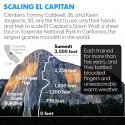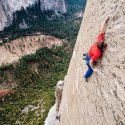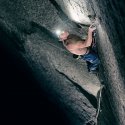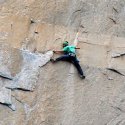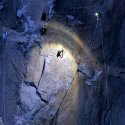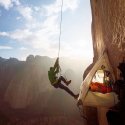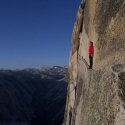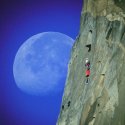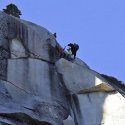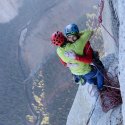National Geographic said:Nineteen days after they set out to achieve one of climbing's most difficult challenges, Tommy Caldwell and Kevin Jorgeson reached the summit of the 3,000-foot rock known as El Capitan in Yosemite National Park on Wednesday, marking the first free ascent of a notoriously difficult section called the Dawn Wall.
Caldwell and Jorgeson reached the summit just after 6:00 p.m. EST, where a contingent of 40 friends and family members, plus a group of reporters, stood ready to greet them, having arrived via an eight-mile (13-kilometer) hike around the backside of the mountain.
"This is not an effort to 'conquer,'" Jorgeson said Tuesday on Twitter, from 2,000 feet (610 meters) up the side of El Capitan. "It's about realizing a dream."
From the start, two and a half weeks ago, the climbing world has been charting their progress. But as the pair moved up the wall and first Caldwell and then Jorgeson successfully made it past the most difficult sections, a much broader, global audience became captivated by the imagery of two men clinging to the most improbable-looking surface of rock by the very tips of their fingers, thousands of feet above the ground.
Free climbing means using one's hands and feet to ascend a rock's natural features, employing ropes and other gear only to stop a fall. At roughly 3,000 feet (915 meters) tall, the Dawn Wall comprises 32 "pitches"—or 32 rope-lengths—of climbing.
Caldwell's and Jorgeson's goal was to free climb all 32 pitches—without falling and without returning to the ground in between. If one of them fell while attempting a pitch, he would have to try that individual pitch from its beginning again.
They began their ascent on December 27, and committed to living up on the side of El Cap for as long as it took each of them to free climb every pitch in succession. Their base camp consisted of three portaledges—each one a six-foot by four-foot (2-meter by 1-meter) platform with tent fly, suspended by nylon straps and hanging from bolts in the sheer granite wall. For breakfast they ate whole-wheat bagels topped with cream cheese, red bell pepper, cucumber, and salami or salmon. At night, they sipped whiskey. Every few days, one of the friends waiting on the ground ascended 1,200 feet (366 meters) of rope to bring the team a new cache of supplies and water.
Over the first six days, they made quick work of the initial 14 pitches—some of the hardest pitches of all. During their five previous attempts at the Dawn Wall, spread out over as many years, they had never even made it past pitch 12. When they both accomplished pitch 14 on January 1, it seemed as though the duo stood a real chance of success.
After pitch 14, Caldwell, 36, the more experienced climber of the two, kicked into high gear. He continued to complete grueling pitch after grueling pitch over the next seven days. After two weeks on the wall, Caldwell had free climbed the first 20 pitches, beyond which only easier sections remained.
Jorgeson, 30, meanwhile, stalled out on pitch 15. For ten days in a row, he continued to fall during each of his attempts. Time was a factor—the longer the climbers were on the wall, the greater chance of a weather front moving through and forcing the climbers to descend. The chance for success was literally slipping through Jorgeson's bandaged and bloody fingertips, and he was painfully aware that he was holding his partner back. If he didn't do pitch 15 soon, Caldwell would have to decide whether to move on alone.
"More than anything, I want to top out together," Caldwell said on day 13. "We gotta make that happen. It would be such a bummer to finish this thing without Kevin. I can't imagine anything worse, really."
On January 9, Jorgeson finally broke through and completed pitch 15 without falling. The success reenergized the team in a major way, as Jorgeson caught a second wind. He describes experiencing a profound "resolve" to match his partner's high point, at the top of pitch 20. He started to climb as if a fire had been lit within.
By Monday, both Caldwell and Jorgeson had reached a ledge dubbed Wino Tower. Below them was 2,000 feet (610 meters) of the hardest free climbing ever completed on El Capitan. Over the next two days, the climbers continued the remainder of their ascent—a stroll compared to what they had already been through.
The Dawn Wall is the steepest, tallest, blankest section of El Cap—and one of the monolith's most storied sectors.
and Dean Caldwell (no relation to Tommy) had climbed the "Wall of the Early Morning Light," aka the Dawn Wall, . Aid climbing involves standing on nylon ladders that are clipped to pieces of gear attached to the wall.
Harding's and Caldwell's ascent became the subject of national news when, after 22 days of living on the wall—sleeping in hammocks and drinking numerous bottles of wine—a four-day storm blew in, and the two climbers famously turned down the National Park Service's attempt to rescue them.
In 1970, simply trying to reach the summit of El Capitan, by any means, was considered a worthy goal. Climbing techniques, equipment, and levels of skill were still quite rudimentary compared to today. In 1970, for example, no one would've ever believed that El Capitan could be free climbed.
In every way the performance of these two climbers has been a giant production. An intricate web of rigged ropes allowed the climbers to move from pitch to pitch, as they worked on free climbing each one in succession. The ropes also provided a way for a small camera crew to document their efforts. A line to the ground allowed friends to provide the climbers with supplies, water, and food.
Free climbing is much more athletic than aid climbing. Free climbing does not mean climbing with no ropes—that's free soloing, a highly risky style of climbing practiced only on occasion by relatively few in the climbing world.
Still, it's an arduous process, requiring a climber to use only the natural features of the rock to advance—cracks in which to wedge one's hands and edges to curl one's fingertips over.
The climbers wear harnesses and are each tied to one end of a 200-foot-long rope (61 meters), which is clipped, via carabiners, to various types of climbing gear, from camming units that fit in cracks to expansion bolts that have been pre-drilled into the rock. They only rely on this equipment to catch them if they fall.
Caldwell and Jorgeson have made five attempts over the past half decade to free climb the Dawn Wall from bottom to top. Over the years, highs and lows have abounded. In 2011, Jorgeson took a fall on pitch 16 and pulled ligaments in his ankle, sidelining him for the rest of the year.
In 2013, Caldwell fractured a rib when he dropped a hundred-pound haul bag that was attached to his harness via a hundred-foot rope; the force of the bag hitting the end of the line pulled the rib out of place. Also that year, , including Yosemite, stealing away valuable time for the climbers to spend on the route.
For Caldwell, this achievement has come to represent the culmination of all his years of climbing, and all that climbing has taught him about achieving big goals in life.
"For me the Dawn Wall is the perfect venue for some of the most important values I want to show [my son] Fitz," Caldwell wrote on Instagram alongside a picture of him hugging his son. "Optimism, perseverance, dedication and the importance of dreaming big."
You are using an out of date browser. It may not display this or other websites correctly.
You should upgrade or use an alternative browser.
You should upgrade or use an alternative browser.
Climbers Complete 19-day Free Climb Of El Capitan (3,000 Ft)
- Thread starter Jeff Head
- Start date
antiterror13
Brigadier
really amazing, almost 1 km vertical. This achievement I believe close to what Sir Edmund Hillary and Tenzing had achieved when they became the first to "conquered" Mount Everest in 1953, more than 60 years ago
Miragedriver
Brigadier
Wow! My toes are curling in my shoes. I got way too nervous just looking at the pictures.
Back to bottling my Grenache
Back to bottling my Grenache

